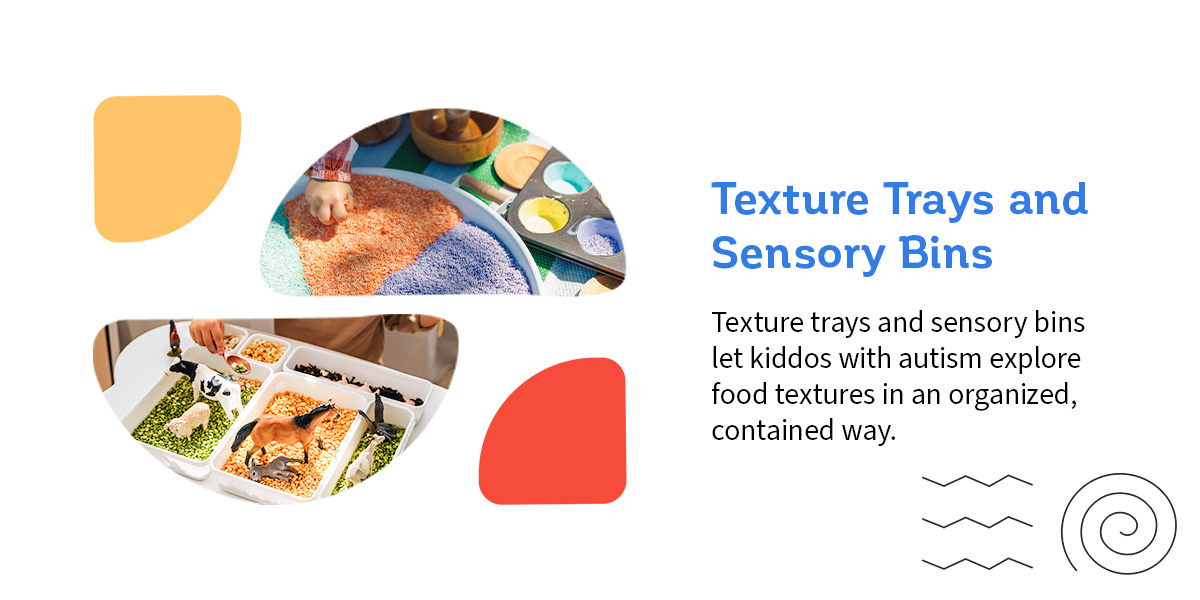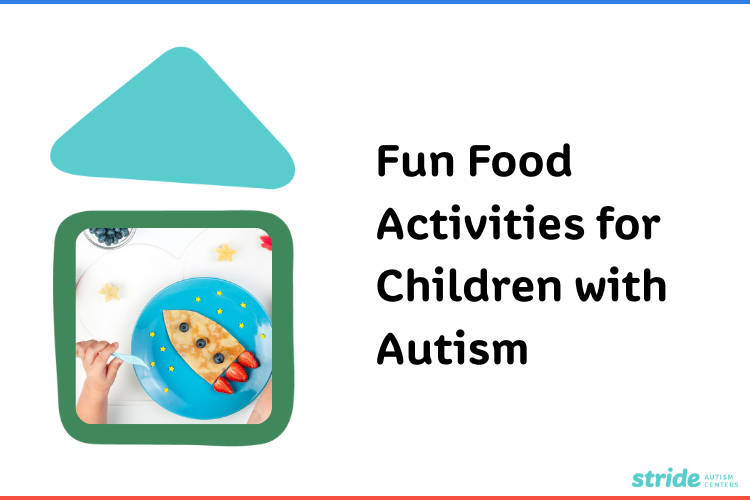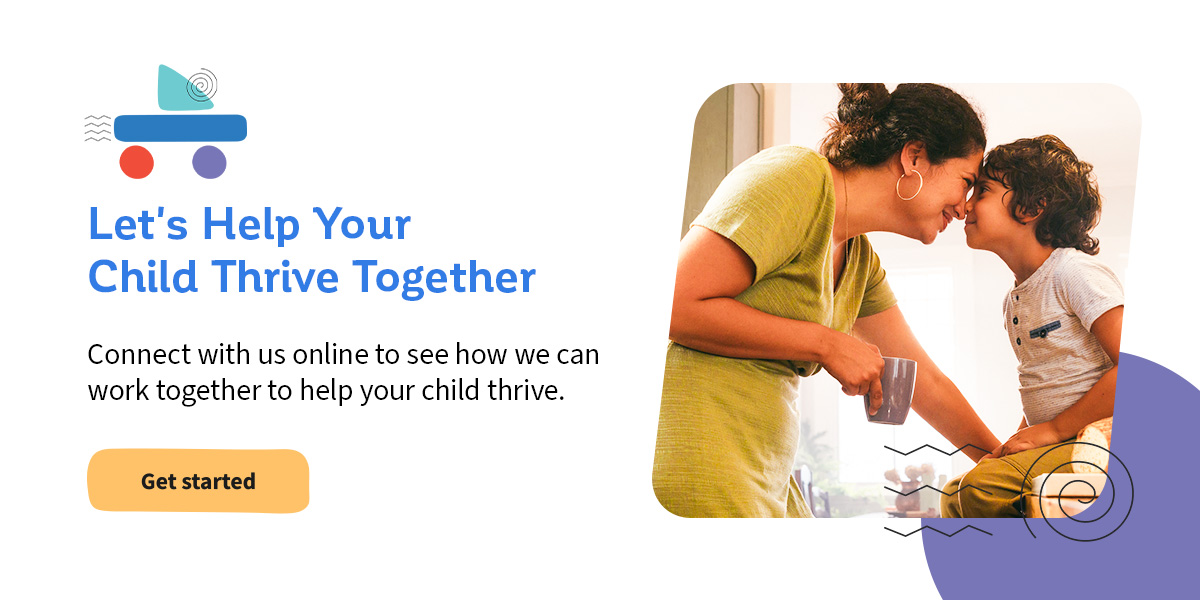New foods can feel big for children with autism — and for parents and caregivers like you. If your kiddo isn’t ready to try new foods yet, that’s okay! A few ways to explore new foods with your child include playful activities that build comfort with new tastes, colors, smells, and textures in tiny, predictable steps. Let’s explore the connection between food, play, and Applied Behavior Analysis (ABA) and some quick, no-pressure food exploration tips you can try at home.
The Connection Between Food Play for Children With Autism and ABA Therapy Goals
Many autistic kiddos find new foods challenging at first. Play turns those moments into safe, fun practice. When you use play, structure, and positive reinforcement — the core of ABA therapy — you give your child real choices and fun reasons to engage. It’s all about participation since tasting stays optional.
Playful food activities also help support ABA therapy goals like:
- Increasing food acceptance in children: Play breaks up big steps into smaller ones. Looking, smelling, and touching at your child’s own comfort level builds familiarity with new foods.
- Reducing food-related resistance: Predictable routines, clear choices, and the ability to opt out reduce stress and keep participation positive.
- Improving tactile tolerance: Graded sensory input, such as starting with tools or gloves first, lets your child explore textures and take the next step at their own pace.
- Enhancing communication around food: Simple language and visual supports help your child request, comment on, or politely decline new foods.
- Pairing food with community to enrich social skills: Playing food-related games with family members and peers introduces important social concepts like taking turns, waiting, and cheering for others. The shared play makes new food experiences feel safer and more fun.
Set Up Sensory Exploration Stations to Experience New Foods
Sensory exploration stations are a great way to start transforming mealtimes. These stations are quick and easy to set up, and they let your child experience new foods through looking, touching, and smelling without the pressure to taste.
Mystery Boxes and Bags
Mystery boxes and bags are the perfect starting point since they allow your child to feel foods without seeing them first. This can help make touching new textures feel less scary or overwhelming. Try out these ideas:
- Small cardboard boxes with a hole for little hands
- Cloth bags and drawstrings
- Shoeboxes with a sleeve
It’s best to start with familiar foods that your child already accepts. Choose whole, sturdy foods like apples and oranges or an unpeeled banana. Dry pasta shapes, lemons, and potatoes are also great choices. Ask questions about what your child feels, such as whether it’s smooth or bumpy, and celebrate any descriptions they offer. You can also increase the playfulness by allowing your child to put items in the box for you to guess.
Smell Tests
Smell tests offer a gentle way to explore new foods since almost 80% of taste comes from our sense of smell. These tests are simple to create with everyday items, like clean spice jars, empty salt shakers, or small containers with holes in the lid.
Start with familiar, pleasant scents your kiddo may enjoy, such as:
- Fruit pieces or peels
- A cinnamon stick
- Fresh herbs, such as peppermint or basil
- Peanut butter
Amp up the playfulness by asking simple questions like whether it smells sweet or nutty. You can also turn this activity into more of a game and take turns with your child. For example, use two jars and have your child identify the one with a specific scent, or let your child make a smell mystery for you.
If your child is more sensory-sensitive, start with milder scents and keep containers further away. Consider offering a paper fan, and always let your kiddo control how close they get to the smell.
Texture Trays and Sensory Bins

Texture trays and sensory bins let kiddos with autism explore food textures in an organized, contained way. They’re easy to create with everyday items like:
- Divided plates
- Muffin tins
- Small plastic bins and bags
Fill each section or container with foods that offer different textural experiences. Some great choices include:
- Dry pasta, beans, or rice for scooping and dumping
- Smooth yogurt in a zip-close bag for squishing
- Crackers for breaking or crumbling
- Cool, cooked noodles for stretching
Include familiar foods your kiddo already accepts alongside new ones to help build comfort. Exploration is often easier and more fun with tools like spoons, scoops, or brushes.
Smaller portions can help keep kiddos from getting overwhelmed, and you can vary the activity based on your child’s personal sensory tolerances. Sensory seekers may appreciate differences, such as the crunchiness of dry cereal or the temperature of cold grapes in a zip-close bag. For kiddos who are sensitive to sensory experiences, offer utensils or gloves they can use to explore instead.
Tips for Success With Sensory Stations
Keep these ideas in mind to help make sensory exploration positive and pressure-free:
- Try just one station type at a time, starting with what you feel will be most comfortable for your child.
- Stay close by for supervision, support, and positive feedback.
- Keep mystery box and texture tray sessions short since brief activities often feel more manageable.
- Let your child know they can opt out, end, or take a break when they need to.
- End on a positive note before your kiddo gets too overwhelmed — watch their cues carefully.
- Always offer immediate praise or a small reward to celebrate every win like touching with tools or describing what they notice.
Transform Food Into Art
Creating art projects together is another fun way to explore new foods!
Consider painting with colorful purees, using a plate or parchment as a canvas. A few slices of fruit or vegetables can make great “stamps” for your budding young artist. Making silly faces and colorful rainbows with food is another activity that many autistic children enjoy. As your child works, narrate with simple sensory words and colors, such as asking if they’d like red or green next.
Try inviting tiny next steps, like touching or smelling the food. If direct touch is tough for your kiddo, offer tools or gloves. It’s okay to model the behavior yourself, too. Explain what you’re doing, or let them choose what’s next. Remember that watching, directing, and commenting are great ways to participate.
It’s best to keep the portions limited to help prevent overwhelm. Food art projects may take a bit longer, but you’ll still want to look for cues that your kiddo needs a break. As with any food-related play activity, constant supervision and celebrating every effort are a must.
Engage in Food-Themed Games
Food exploration for children with autism becomes even more engaging with these structured games.
Food Bingo
Food bingo starts with a picture-based card with a mix of familiar, accepted foods and new ones. Your child can mark squares by eating a food they’re comfortable with, while earning the square for new ones simply by touching, looking, or smelling. Having the whole family join in and using stickers to indicate progress makes it even more playful and reinforces budding social skills. You can try tying each “bingo” to a reward to keep everyone engaged and extend the game for as long as you like.
As with other games, include options for your kiddo to decline. Offer positive reinforcement like immediate praise every time your kiddo marks a new square to celebrate their efforts.
Two-Bite Taste Test
This simple game lets your child be in charge while keeping portions tiny and manageable. Offer two small bites of food, one familiar and one new, and have your kiddo choose which to try first. They may prefer the familiar one to start, and that’s okay — it can help them build their confidence.
Keep it playful by:
- Using pea-sized bites.
- Allowing a no-thank-you option.
- Letting your child set the pace.
- Modeling trying foods yourself first.
- Making it social with siblings or family members.
- Using a fun, three-two-one-touch countdown.
Varying the approach can make the activity more interesting and engaging. Consider doing it with siblings in the park as a picnic, or pretend you are chefs and use toy kitchen items to “prepare” the food.
Let’s Help Your Child Thrive Together
Stride Autism Centers offers personalized, center-based ABA therapy for autistic kids ages 2 through 6 across the Midwest. We’re fully accredited by the Autism Commission on Quality (ACQ) in Illinois, Iowa, and Nebraska, and we use an evidence-based program to help your kiddo build essential skills through play, structure, and positive reinforcement. In our centers, your child learns and grows through naturalistic group activities and individualized one-on-one therapy in a supportive, sensory-friendly environment.
Call our caring, experienced team at 515-207-5251 or connect with us online to see how we can work together to help your child thrive.







